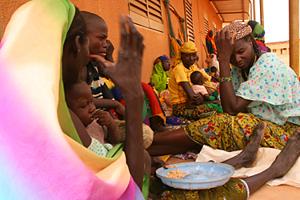
In Simiri, Niger, 85 children are acutely malnourished. Caritas member, CRS delivered vegetable oil and corn-soy blend for children under 2 years old.
Credits: Lane Hartill/CRS
By Lane Hartill, Catholic Relief Services (CRS)
Habsu Boubacar has got used to being hungry.
The burning stomach, the blurred vision, the joint pain: Habsu has learned how to work through aches, how to force herself to go on.
Growing up in Toudoun Jaka, a sand-blasted village full of skeletal cattle and bone-thin dogs that slink through the sand, Habsu learned how to cope.
She learned how to mix water and millet husks—the stuff she normally feeds to the goats and sheep—and make a sludgy drink. She learned how to gulp the brown, gritty stuff so the bitterness doesn’t sit too long on her tongue. She got used to the feel of it in her stomach; it fills a space, so she can feed the real food to her four kids.
What she hasn’t got used to is anza. The plant is “famine food” and only the hungriest donkeys would nibble at it during normal times. Its fruit is so bitter and tough Habsu has to boil it several times to get the bitterness out of it. Then she adds tobacco to soften it. She eats it, like most people do, when there’s nothing else.
Hunger in Niger is a recurring theme, a slow-burning problem that doesn’t make headlines.
Nigeriens have known for months this would happen. When the rains failed to show up last year—influenced by the El Niño phenomenon—everyone knew that food would be scarce.
But the numbers are startling. The UN estimates that 7.5 million Nigeriens—roughly half the country—don’t have enough food to eat.
The Caritas confederation (which includes CRS as a US member) has been delivering food and seeds, screening women and children for malnutrition, running cash-for-work and training projects and raising awareness about hunger issues.
The rain never came to Toudoun Jaka last year, and the land withered and cracked. Habsu’s millet crops shrivelled and died. She wasn’t able to put any grain away for her or her 4 kids.
She and her husband grappled with a single question: To stay or leave Toudoun Jaka. Habsu’s husband, along with other men in the village, decided to go to the capital, Niamey, where they could work as part-time livestock butchers, a job many here wouldn’t do because of the low-class status associated with it. The little cash Habsu’s husband could send home would partially meet the grocery bill. God would take care of the rest, they thought.
Habsu sold off 3 goats and 3 cows—all listless and scrawny—in order to pay for food. Only 2 goats remain, the ones that are nosing around her daughter, Balki, a smiling girl with warm brown eyes. In the last 6 months, her delicate frame has lost what little extra weight it had on it. Her dusty knees are bulbous compared to her stick-like legs.
Balki and her siblings eat nothing but millet mixed with water, a chalky-tasting porridge with little nutritional value. Habsu can’t remember the last time she served them anything else. No fruit, meat or vegetables. Just millet porridge every meal.
The millet Habsu planted recently has withered and been covered over by blowing sand. Maybe by some stroke of luck, the rain will come and soak the ground and the millet will grow. But even then, nothing will be ready to harvest for another couple of months. So Habsu has a backup plan: the stack of dishes near her sagging four-poster bed. She will sell them to buy food. Until then, it’s millet husks and that vile green fruit, anza.
